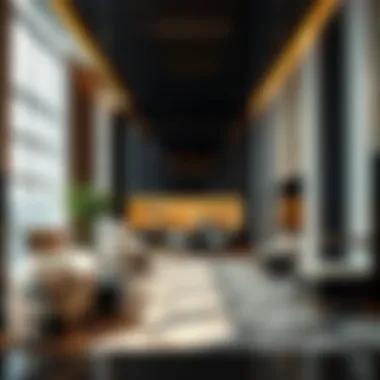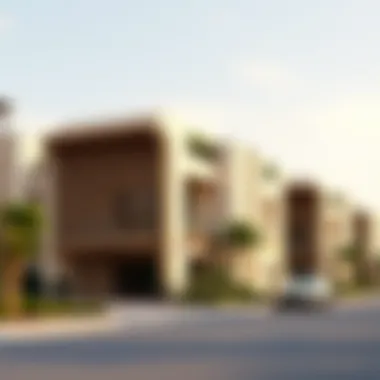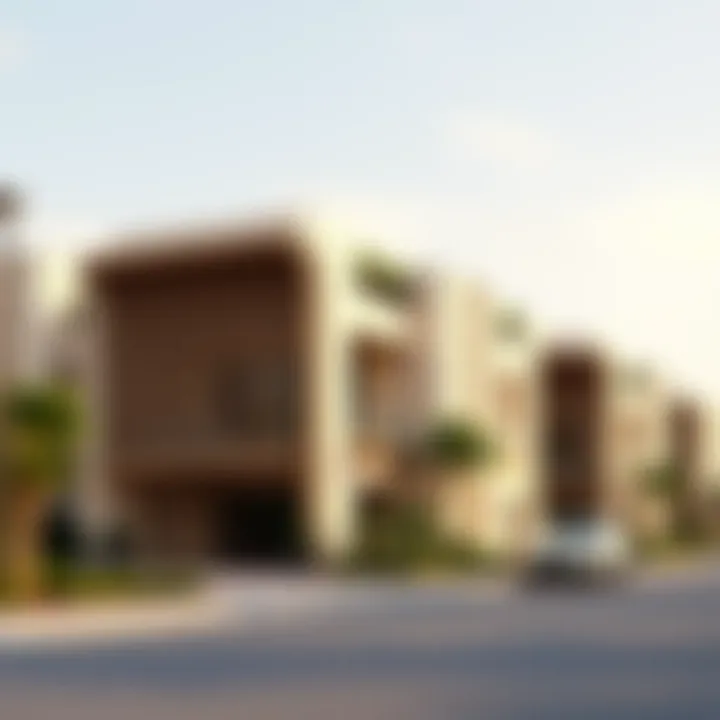Al-Ayid Al-Rashidi: Influencing Dubai's Real Estate Market


Intro
In the fast-paced world of Dubai’s real estate, few names resonate with as much authority and influence as Al-Ayid Al-Rashidi. His remarkable journey paints a vivid picture of how one individual can shape an industry, becoming a cornerstone in the ever-evolving landscape of property development and investment in this remarkable city.
This article explores his vital role, focusing on his contributions that have not only transformed individual neighborhoods but also situated Dubai as a significant global hub for real estate. By investing in innovation, sustainability, and local community engagement, Al-Rashidi has crafted a narrative that is as rich as the skyline that dominates the city. As we navigate through the complexities of market trends, investment strategies, and future predictions, it becomes clear that understanding Al-Rashidi’s influence is crucial for anyone looking to make informed decisions in Dubai’s unique property market.
Market Trends and Insights
Current Market Analysis
The current state of Dubai's real estate market reflects a blend of robust growth and calculated volatility. After a series of fluctuations, the market is gradually stabilizing, largely driven by Al-Ayid Al-Rashidi’s strategic initiatives. He has often emphasized the importance of transparency and sustainability, which has resonated with international investors. Properties designed with energy efficiency and smart technology are increasingly gaining traction, making them attractive investments.
The demand for luxury real estate remains steadfast. Developers are keen on creating opulent living spaces that cater to both local and foreign buyers. Additionally, there’s a noticeable shift towards mixed-use developments that offer not just residential spaces but also commercial and recreational opportunities, appealing to a broader demographic.
Future Predictions
Looking ahead, the future of Dubai's real estate is poised for intriguing transformations. Analysts agree that as Expo 2020 has left a lasting mark, there will be a sustained focus on innovations that can address the unique demands of a rapidly growing population.
Al-Rashidi advocates for projects that integrate sustainability, making environmentally friendly developments the way forward. This could see a rise in biophilic design principles and more green spaces incorporated into urban environments.
In terms of investment, experts predict a potential shift in focus. As the market matures, there may be a pivot towards long-term rental investments as opposed to rapid buy-sell cycles. This highlights the growing need for understanding the rental market dynamics.
Property Investment Strategies
Tips for First-Time Investors
Diving into property investment can feel overwhelming, especially for newcomers. Here are a few essential tips to consider:
- Research Thoroughly: Understand the areas you’re interested in. Look for market trends, property values, and local amenities.
- Engage with Experts: Don’t hesitate to reach out to local real estate agents or analysts. Their insights can be invaluable.
- Consider Sustainability: As emphasized by Al-Rashidi, properties with sustainable features not only cater to current market demands but also tend to retain value over time.
Understanding the Rental Market
The rental market in Dubai is as vibrant as it is competitive. This segment offers significant opportunities for investors willing to delve deeper. Here are vital aspects to consider:
- Location Matters: Demand tends to be high in areas close to business districts, schools, and transport hubs.
- Market Rate Analysis: Keep a sharp eye on market rates to ensure your investment remains competitive.
- Tenant Management: A good property manager can ease the workload and help maintain tenant relationships, which are crucial for long-term occupancy.
"Investment in real estate is not just about property; it's an investment in the lifestyle of a community. Al-Rashidi's approach exemplifies how understanding this can lead to success."
By keeping abreast of trends, utilizing the right strategies, and understanding Al-Ayid Al-Rashidi's significant impact, investors, homeowners, and analysts can navigate Dubai's dynamic property scene with confidence.
Understanding Al-Ayid Al-Rashidi
Al-Ayid Al-Rashidi is not just a name in Dubai’s real estate arena; he embodies a bridge between tradition and modernity in a rapidly evolving market. Understanding his role offers critical insights into the dynamics at play in Dubai’s property landscape. As an investor, homebuyer, or industry expert, recognizing the significance of Al-Rashidi’s contributions can illuminate key market trends and potential investment pathways. It’s like navigating the desert with a compass—knowing his journey and influence could ensure you don't lose your way amid shifting sands.
Background and Early Life
Al-Ayid Al-Rashidi’s journey begins well before he became a titan of Dubai's real estate sector. He was born into a family with deep-rooted ties to the Emirati culture. Growing up, Al-Rashidi observed the transformations taking place in Dubai as it transitioned from a modest fishing village to a global financial hub. This background provided him with a unique perspective on the importance of preserving cultural heritage while embracing modernity.
His early life was marked by education and exposure to various facets of business, laying a strong foundation for his future endeavors. Al-Rashidi wasn't just a passive observer; rather he was actively engaged in the community, learning the intricacies of Emirati values and traditions. This upbringing didn’t just shape his character—it also influenced his approach to real estate, balancing profit with social responsibility. The person we see today is a mosaic of his early experiences—a mix of cultural appreciation and visionary thinking.
Path to Real Estate
Al-Rashidi's ascent in the real estate field didn’t happen overnight. Following his academic pursuits, he ventured into the business world, initially dabbling in different sectors. However, the pulse of the market drew him toward real estate. One might say that he found his calling amid the concrete and glass that reflects Dubai’s skyline.
With keen instincts and an eye for promising opportunities, Al-Rashidi started small. His first ventures consisted of refurbishing existing properties, a move inspired by his belief in revitalizing old spaces rather than merely erecting new ones. This approach allowed him to carve a niche for himself—one that prioritized quality over quantity. His understanding of market demands helped him spot trends before they caught on, affirming his early status as a thought leader in the field.


As the years rolled on, Al-Rashidi didn’t just build structures; he constructed a legacy rooted in innovation and community-oriented development. His path reflects not just personal ambition, but a broader commitment to shaping the urban landscape of Dubai in ways that respect both heritage and progress.
Historical Context of Dubai's Real Estate Market
Understanding the historical context of Dubai's real estate market is crucial for grasping not just the past, but how it's shaped the present and future of property development in the region. This backdrop highlights the dramatic transformation that has taken place in Dubai over just a few decades. From humble beginnings centered on trade and fishing, it has evolved into a global metropolis, attractive to investors, expatriates, and tourists alike. With a pioneering spirit and ambitious visions, Dubai’s leaders have fostered an economic environment that encourages investment, particularly in real estate.
Dubbed the city of innovation, Dubai's real estate sector showcases a unique blend of luxury, modernity, and cultural elements, making it a vibrant hub for those looking to invest. Understanding how this market has evolved helps homebuyers and investors navigate its complexities. The previous economic climate and the shifts in buyer behavior have all been part and parcel of a larger story.
Economic Growth in Dubai
The economic growth in Dubai has been nothing short of spectacular. Early in the 20th century, the discovery of oil was the turning point that fueled unprecedented development. This boom made way for infrastructural advancements that paved the path for real estate. The city’s economic prosperity attracted an influx of both local and international investors, giving rise to projects that wouldn’t have been possible without such wealth.
Real estate saw a rapid expansion beginning in the late 1990s. The government implemented policies that encouraged private investment, which led to the construction of iconic structures such as the Burj Al Arab and the Palm Jumeirah. As these landmarks arose, they not only reshaped the skyline but also boosted the economy by generating substantial tourism revenue.
Notably, Dubai’s strategic location as a gateway between Europe and Asia made it a desirable destination for global trade. This positioning has helped solidify Dubai's status as a hub for business, contributing to sustained economic growth and subsequently propelling the real estate sector further.
Key Milestones in Development
Several key milestones highlight the development of the real estate market in Dubai, each marking significant progress in its journey.
- The Dubai Land Department was established in 1960, laying the groundwork for organizing land ownership and property transactions.
- The introduction of Freehold Property Law in 2002 revolutionized the market, allowing foreign nationals to own real estate. This law opened the floodgates for international investors, infusing the market with capital.
- The launch of the Dubai Multi Commodities Centre (DMCC) in 2002 also spurred real estate demand, as it attracted thousands of businesses and traders, shifting the economy’s focus to commodities.
- The 2008 global financial crisis posed a challenge yet also provided valuable lessons, leading to stricter regulations, transparency, and better governance in the market.
These milestones not only reflect Dubai’s dynamic development but also signify its adaptability and resilience in facing both challenges and opportunities. By apprehending this historical context, potential investors and homeowners get a clearer picture of the environment within which Al-Ayid Al-Rashidi operates.
Knowing these foundational elements of Dubai's real estate market offers an insight into the trajectories that Al-Ayid Al-Rashidi leveraged for growth and innovation, as we will explore in further sections.
"Dubai's real estate is not just bricks and mortar; it's the embodiment of ambition and vision, interweaving the past with the future."
Understanding these historical dynamics lays the groundwork for analyzing the impact of key figures like Al-Ayid Al-Rashidi in our subsequent discussions.
Al-Ayid Al-Rashidi's Impact on Property Development
Al-Ayid Al-Rashidi stands as a cornerstone in the sprawling realm of Dubai's real estate development. His influence has gone beyond mere building projects; it stretches into the very blueprint of urban planning and economic shaping of the city. As we unpack this topic, it becomes evident that his contributions and strategies have helped not just to erect structures, but also to foster a sustainable growth environment for the overarching real estate market in Dubai.
The significance of examining Al-Rashidi's impact lies in understanding the interplay between innovative development practices, the evolving buyer preferences, and the broader socio-economic implications that his works generate. As Dubai continues to mature as a global city, the implications of his vision gained through years of experience amplify.
Some specific aspects worth noting include the adaptation of architectural styles reflecting cultural heritage, the commitment to creating community-oriented developments, and the harnessing of cutting-edge technology and sustainability principles in construction practices. This section will illuminate these elements, showcasing how Al-Rashidi's decisions not only shaped the physical landscape but also influenced trends and patterns within the real estate market overall.
Major Projects and Contributions
Al-Rashidi is credited with several landmark projects that have significantly transformed Dubai's skyline. His approach often combines luxury with functionality, creating spaces that meet the needs of affluent buyers while also being accessible to a broader population.
- The Burj Vincent – This high-rise has become a residential and commercial hub, embodying upscale living with its state-of-the-art amenities.
- Al-Mohammed City – A visionary mixed-use community that integrates retail, residential, and office spaces, demonstrating the potential for sustainable urban living.
- Green Oasis Development – Focused on sustainability, this project prioritizes green spaces and eco-friendly materials, setting new standards for environmentally conscious development in Dubai.
Through these contributions, Al-Rashidi has not only enriched the real estate landscape but also created a vibrant community ecosystem that attracts both local and international investors.
Innovative Approaches to Development
Innovation shines brightly in the methodologies that Al-Rashidi applies in his projects. Embracing technology and forward-thinking strategies has enabled him to anticipate market shifts and buyer desires. For instance, his projects often incorporate smart technologies, providing residents with advanced home automation systems that enhance security and energy efficiency.
Moreover, his emphasis on adaptive reuse of existing buildings exemplifies a commitment to sustainability and preservation of cultural identity. By giving older structures new life, he minimizes the carbon footprint associated with new construction, aligning with the global trend towards greener building practices.
Collaborations with the Government
Al-Rashidi's impact is further magnified through strategic alliances with governmental agencies. His collaboration with Dubai's municipality has facilitated seamless integration of his commercial projects with urban land-use policies, ensuring that development aligns with the city's long-term vision.


"A city's growth lies not just in its buildings, but in the thoughtful dialogue between public and private sectors."
That statement rings true in Al-Rashidi's pursuits. Collaborative efforts have often translated into large-scale infrastructure projects, enhancing connectivity and accessibility, making his developments not just standalone pieces, but part of the larger fabric of Dubai's urban growth.
Through these collaborations, Al-Rashidi navigates complex regulatory landscapes, which can be a significant hurdle in real estate development, and turns potential pitfalls into opportunities for growth.
Influence on Market Trends
The real estate market in Dubai is as dynamic as the city itself, constantly shifting and molding in response to a variety of influences. Among these influences, Al-Ayid Al-Rashidi's contributions to market trends hold significant weight. His understanding of buyer behavior, market wants, and sustainable practices has fundamentally altered how properties are developed and marketed, making him a pivotal character in this landscape. Understanding these elements is essential for anyone looking to navigate this multifaceted market.
Shifts in Buyer Preferences
The preferences of buyers have undergone noteworthy transformations, particularly in the wake of Al-Ayid's initiatives. Today’s buyers lean heavily towards properties that align with their lifestyles rather than just mere investments. This shift is reflected in greater demand for amenities that enhance quality of life—swimming pools, community parks, and wellness centers are becoming staples in newer projects.
A recent survey indicated that over 65% of potential buyers value lifestyle and community features equally with proximity to work. This shift has sparked developers to rethink their designs, with many opting for layouts that encourage community interaction while also catering to privacy.
In an environment where buyers have more choices than they can shake a stick at, having a finger on the pulse of these shifting preferences is key to making successful investments.
Emergence of Luxury Properties
Dubai has long been associated with opulence, but under Al-Ayid Al-Rashidi, the luxury market has reached new heights, transforming the skyline and redefining luxury living. His focus on high-end properties has invigorated interest from international investors, as well as affluent locals seeking exclusive residences.
Luxury properties highlight unique features, from breathtaking views to personalized design elements that speak to affluent tastes. Properties like the Palm Jumeirah or the Downtown Dubai towers are prime examples of how luxury sits hand in hand with innovative technologies like smart home systems and eco-friendly designs.
The surge in high-net-worth individuals looking to stake their claims in Dubai illustrates the demand for these lavish investments. With the luxury segment growing rapidly, investors are keenly evaluating opportunities that promise both value and status.
Sustainability in Real Estate
In an era where climate change is a pressing concern, Al-Ayid Al-Rashidi has also championed sustainability in the development conversation. Buyers, particularly millennials and Gen Z, increasingly demand properties that meet energy-efficient standards and promote environmentally friendly practices. Al-Ayid has pushed for projects that incorporate sustainable materials, renewable energy sources, and outdoor green spaces that can temper the harsh desert environment.
This trend is reflected in the growing popularity of sustainable communities such as The Sustainable City, a development that prioritizes ecological balance while offering luxury living. They integrate solar panels and rainwater harvesting which resonate well with eco-conscious buyers.
The pivot towards sustainability is not only ethical but practical, as eco-friendly homes often command higher resale values and attract a broader array of investors. It represents a savvy investment choice in a world that increasingly values sustainability alongside luxury.
Challenges Faced in the Market
Navigating Dubai's real estate market comes with its own share of challenges, particularly under the influence of key figures like Al-Ayid Al-Rashidi. The landscape is not merely a venue for buying and selling properties; it’s a complex web where politics, economics, and social dynamics intertwine. Understanding these challenges is crucial for anyone involved, be it investors, homebuyers, agents, or analysts. Here’s a closer look at the primary hurdles that shape the market today.
Regulatory Hurdles
One of the largest barriers affecting real estate in Dubai is the regulatory environment. With changes in government policies and new regulations continuously emerging, keeping up with compliance can feel like trying to hit a moving target. Investors sometimes face lengthy approval processes for projects, which can delay development and increase costs.
- Government Inspections: Mandatory inspections often uncover issues that require additional time and resources to rectify.
- Licensing: The necessity for various licenses and permits can be a tangled mess; each one demands specific requirements that may not always be easily accessible.
These regulatory issues can lead to frustration and even loss of funds for developers, especially those who are not familiar with local laws. Al-Ayid Al-Rashidi has often advocated for more streamlined processes, believing that easing these hurdles could attract more foreign investment.
Market Fluctuations
Real estate is inherently volatile, influenced by both local and global market conditions. Fluctuations in prices and demand can significantly impact property values. For a city like Dubai, known for its swift rises and falls, understanding these market ups and downs is essential.
- Seasonality: Property demand often fluctuates with the seasons, affecting when to buy or sell.
- Buyer Confidence: Economic downturns can shatter buyer confidence, leading to a significant dip in transactions.
Al-Ayid Al-Rashidi has encountered several market shifts over the years, each compelling him to adapt strategies that not only protect his investments but also stabilize the properties under his management. By observing trends, he can often anticipate which way the market will swing next, providing a competitive edge.
Global Economic Factors
Lastly, it’s imperative to acknowledge the influence of global economic factors on Dubai's real estate sector. Fluctuations in the global economy can ripple through local markets, sometimes with devastating consequences. For instance, international trade relations, oil prices, and foreign investment trends can impact how investors perceive the market.
- Foreign Relations: Political decisions affecting trade can directly impact investor sentiment.
- Oil Prices: Oil market downturns can restrict spending power, particularly for industries reliant on energy prices.
Al-Ayid strives to stay informed about these broader economic indicators. He believes that true success lies in anticipating changes beyond local trends. To thrive, adapting to the global chessboard is essential for anyone involved in Dubai’s real estate.
Future Prospects for Dubai's Real Estate
The landscape of Dubai's real estate is ever-changing, shaped largely by numerous domestic and global factors. Understanding the future prospects of this market is crucial not just for investors, but for homebuyers and industry analysts as well. What lies ahead can provide insights into strategic decision-making and investments that are more informed. With the rapid evolution of urban development, shifting buyer preferences, and advancements in technology, the future of Dubai’s real estate holds myriad opportunities and challenges.


Predictions for Market Growth
Several indicators suggest a positive trajectory for the real estate market in Dubai. First, the government has introduced various initiatives to attract foreign investment, which is likely to drive demand. As the UAE grows as a global business hub, investors from various countries are showing keen interest in Dubai properties.
Moreover, demographic trends illustrate a growing population, primarily comprising young expatriates and professionals looking for modern living spaces. Since housing satisfaction is influenced by location and amenities, areas like Dubai Marina, Jumeirah Village, and Downtown have become highly sought after due to their vibrant community features.
- Key Predictions for Growth:
- Continued urbanization and infrastructure enhancement
- Increased investment in luxury and high-end properties
- An influx of expatriates relocating due to job opportunities
- Expansion of public transport systems which enhance property accessibility
These predictions indicate not only potential profitability but also an evolving consumer base interested in properties that are more than just a place to stay.
Technological Innovations in Real Estate
The future will likely be heavily influenced by technology, transforming traditional real estate practices into more efficient models. Innovations like virtual reality (VR) and augmented reality (AR) are becoming commonplace in property viewings, allowing potential buyers to engage with properties in ways that were not possible before. This shift can drastically enhance the buyer's experience and streamline the decision-making process.
Furthermore, the advent of smart buildings is likely to change property management. Implementing features like energy-efficient systems and smart home technologies will not only appeal to environmentally-conscious buyers but also apply long-term savings in utility costs.
- Technological Trends to Watch:
- Integration of AI in property valuation and risk assessment
- Increased use of blockchain technology to enhance transaction transparency
- Developments in mobile applications for property management and listing
"Innovative technology coupled with a paradigm shift in buyer expectations sets the stage for a transformative future in Dubai's real estate market."
Investment Opportunities in the Current Landscape
In today’s ever-shifting economy, the investment landscape in Dubai’s real estate sector presents a blend of unique opportunities and challenges. Al-Ayid Al-Rashidi's endeavors shaped not just properties but also the entire framework of what makes a sound investment in this vibrant city. As his vision aligns with the market's evolution, investors find themselves at a critical juncture, where the right choices could yield significant returns. This section dives into the various elements to consider when looking towards investment in Dubai’s current context, exploring both the auspicious neighborhoods and the inherent risks involved.
Best Neighborhoods for Investment
Identifying promising neighborhoods is quintessential for any investor wanting to dive into Dubai’s real estate market. Several areas have developed rapidly, becoming prime spots for investment.
- Dubai Marina: Once a mere vision, now it's a thriving hub. With its stunning waterfront views and a plethora of leisure activities, Dubai Marina has attracted both expatriates and locals alike. The rental yields here have remained relatively high.
- Downtown Dubai: Home to the iconic Burj Khalifa, properties in this area are always on demand. The luxury market thrives in Downtown, providing investors a chance to tap into upscale clientele.
- Jumeirah Lakes Towers (JLT): This community offers a more affordable entry-point, boasting a vibrant lifestyle with parks and dining options. The ongoing development in this area makes it a noteworthy contender for investors looking for growth potential.
- Arabian Ranches: For those leaning towards family-oriented environments, Arabian Ranches offers serene living with access to quality schools and exemplary amenities, appealing to long-term renters.
With these neighborhoods, investors should carefully evaluate their personal investment goals and the time horizon for yield realization.
Risk Assessment for Investors
Investing in real estate inherently involves risk, and Dubai is no exception. Understanding these risks is fundamental for any investor looking to make sound decisions.
- Market Fluctuations: The property market can be unpredictable. Economic variables, such as oil prices and global market conditions, may influence demand and prices. It's essential to monitor trends actively.
- Regulatory Changes: Continuous shifts in regulations can affect investment viability. Having a local expert or doing thorough research about potential legal obstacles can save investors from financial disappointment.
- Property Management Challenges: Owning property doesn’t stop at acquisition. Investors should consider the cost and efficiency of property management services, as poorly managed properties could lead to increased vacancy rates and diminished returns.
- Cultural and Economic Risks: As a city that attracts a global population, understanding cultural dynamics and economic sentiment can offer insights into consumer preferences, which ultimately influences property values.
For anyone eyeing Dubai's vibrant real estate market, these assessments represent pivotal components of the investment decision process. Expanding ones knowledge and awareness of the landscape helps mitigate risks while enhancing the ability to generate favorable returns.
Investing isn’t just about buying properties; it’s about understanding the pulse of the market. The insights about burgeoning neighborhoods and potential risks are crucial for navigating Dubai’s real estate effectively.
End
In examining the profound influence of Al-Ayid Al-Rashidi within the Dubai real estate sphere, it becomes clear that his contributions extend far beyond mere transactions and developments. His vision for the industry has transformed not just the landscapes of buildings, but also the very fabric of Dubai as a global real estate hub. This article emphasizes crucial elements like innovation, sustainability, and the synergy between public and private sectors that Al-Rashidi has fostered, highlighting how his approach to developments has continually aligned with the evolving desires of investors and homebuyers alike.
Summary of Key Points
- Strategic Influence: Al-Ayid Al-Rashidi's strategic insights have guided significant shifts in market dynamics, aligning property development with global trends.
- Innovative Practices: His innovative methods have introduced modern architectural designs and sustainability practices that are now benchmarks for developers throughout Dubai.
- Government Collaboration: By working closely with government entities, he has paved the way for beneficial regulations that support growth and attract international investment.
- Market Trends: His understanding of buyer preferences has influenced the rise of luxury properties and green developments, which cater to a more discerning clientele.
In essence, the role of Al-Ayid Al-Rashidi encapsulates a forward-thinking mindset that is essential for navigating the complexities of the real estate market in Dubai.
Final Thoughts on Al-Ayid Al-Rashidi's Legacy
Al-Ayid Al-Rashidi is not merely a name in Dubai’s real estate history; he stands as a testament to what can be achieved through vision and dedication. His legacy is characterized by a commitment to quality, sustainability, and a relentless pursuit of excellence. As Dubai continues to evolve, the foundations laid by leaders like Al-Rashidi will undoubtedly influence future generations of developers. His work ensures that Dubai remains not just a city of skyscrapers, but a model of integrated, thoughtful, and forward-looking real estate development.
As the market adapts to new technologies and changing demographics, the principles established by Al-Rashidi will remain relevant, allowing Dubai to thrive in a highly competitive arena. Observing his impact invites both admiration and inspiration for all who aim to leave a mark in this burgeoning field.





